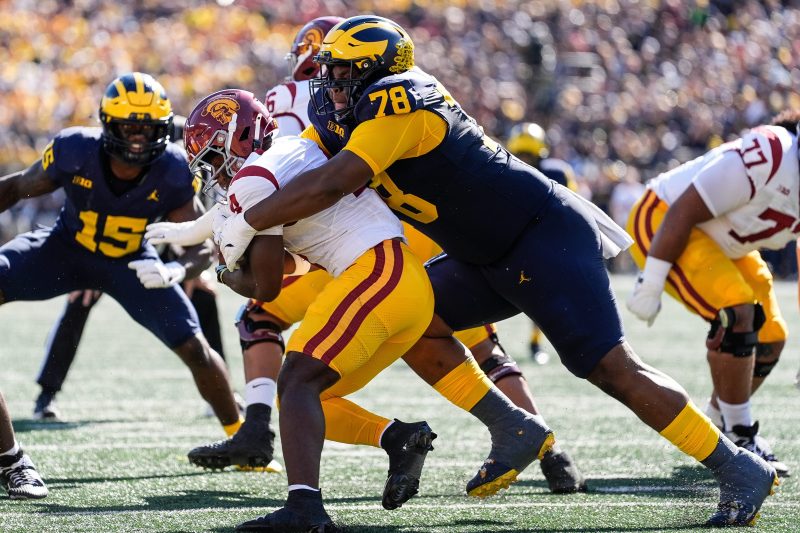This article was updated to add new information.
It seemed for most of the second half in the Big House that No. 12 Southern California was ready for life in the Big Ten.
That may still be the case: Down 14-3 at the break and with nothing working offensively, the Trojans flipped the script in the second half against No. 17 Michigan and were only a late defensive stand away from kicking off life in the new conference on a very high note.
But the Wolverines scored on a 1-yard run by Kalel Mullings with 36 seconds left and pulled out a 27-24 victory that keeps the defending national champions in the College Football Playoff mix and leaves USC and coach Lincoln Riley frustrated over a win that got away.
There are things to like about the Trojans’ Big Ten debut. For one, the shift in physicality and production on both lines in the second half suggests USC is ready for the style of play in this conference.
Meanwhile, the Trojans were able to augment this running attack with a solid game from quarterback Miller Moss, who was pressured and under duress from the Wolverines’ pass rush but finished with 283 passing yards and three touchdowns. On the other side of the field, Michigan got nothing from quarterback Alex Orji. Making his starting debut, he had 32 passing yards and 43 yards on the ground.
After reeling in new defensive coordinator D’Anton Lynn from rival UCLA this winter, the Trojans are also seeing the sort of improved results that could keep this team in the mix for an at-large playoff bid.
But there are also plenty of unresolved question marks. The first is the Trojans’ ability to protect the quarterback, very much in doubt after Saturday. Another is whether USC can afford to stumble out of the gate, as on Saturday, and rally back against a team such as No. 10 Penn State; the Nittany Lions go to the Coliseum on Oct. 12. While they kept Michigan run game in check for long stretches, the defense allowed three big plays, including a 63-yard run to Kalel Mullings on the game-winning drive. The Wolverines finished with 290 yards rushing.
And there’s some question about what it means to lose to Michigan. The Wolverines are inept offensively and clearly not built to contend for another national title. But when it counted, they had enough to hand USC a painful setback as new members of the Big Ten.
The Trojans, Michigan and Utah lead college football’s winners and losers from Week 4:
Winners
Tennessee
Get your tickets now, because seats on the Tennessee bandwagon are going fast. The No. 7 Volunteers showed why they are one of the best teams in the country and a real national championship contender by pushing around No. 13 Oklahoma in a 25-15 road win. Offensively, young quarterback Nico Iamaleava wasn’t perfect and UT played more conservatively than usual, though the running game was able to set an early tone and put the Sooners on their heels. The bigger story is on defense. The Volunteers have given up just two touchdowns in four games and limited OU to just 222 yards of offense and 1.1 yards per carry. On both sides of the ball, Tennessee looks like a very elite team.
Utah
No. 10 Utah’s 22-19 win at No. 15 Oklahoma State places the Utes alongside No. 14 Kansas State as the cream of the crop in the Big 12, a slight step ahead of under-ranked No. 21 Iowa State and underrated Central Florida. That’s in big part because the Utes did so without quarterback Cam Rising in the lineup, meaning there might be another gear they’ve yet to tap into through four games. With the senior again sidelined — injuries are a constant concern for Rising, who’s excellent when healthy — coach Kyle Whittingham turned to backup Isaac Wilson, who tossed a pair of interceptions but was bailed out by running back Micah Bernard’s 182 yards on 25 carries. So the big story was the play on defense: Utah chewed through two OSU quarterbacks, gave up just 38 rushing yards and showed why it’s more than ready to make a playoff push.
Clemson
After scoring 56 points in the first half of a 66-20 win against Appalachian State two weeks ago, No. 19 Clemson dropped 45 first-half points against North Carolina State and sailed to a 59-35 win against a would-be ACC contender. (Turns out the Wolfpack are very much not that.) This explosiveness comes after a 34-3 loss to Georgia in the season opener raised an additional round of questions about the Tigers’ underachieving offense. While the Mountaineers and Wolfpack are not exactly elite competition, this quick turnaround strongly suggests Clemson is a legitimate ACC player and a contender for the playoff, whether as the conference winner or via an at-large bid. Quarterback Cade Klubnik had 209 yards and four total touchdowns against NC State and has a combined 11 scores across these past two games.
Indiana
The strength of schedule isn’t impressive: Florida International, Western Illinois, UCLA and Charlotte. The final scores are, though: 31-7, 77-3, 42-13 and 52-14, respectively. With transfer quarterback Kurtis Rourke at the controls, the Indiana offense looks like one of the best in recent program history while new coach Curt Cignetti looks like one of the more inspired hires of this past offseason. After Saturday’s rout over Charlotte, the Hoosiers are unbeaten through four games for the first time since the 2020 season — Indiana’s only ranked finish since 1989 — while Cignetti is the first new coach in program history to start his tenure 4-0.
Florida State
FSU finally got into the win column on its four try by topping California 14-9. Wins are good — better than losses — and maybe no team needed one more than the Seminoles, previously seen cratering to the most disappointing start in program history. Not that this is the sort of victory that does much to increase optimism: Cal is pretty good but nowhere near great, and the Seminoles were outgained by more than 100 yards while DJ Uiagalelei continued to struggle. In the end, the win came down to two missed field goals by the Golden Bears, both inside 40 yards.
Colorado
With Colorado trailing Baylor 31-24 with one play left in regulation, Shedeur Sanders rolled to his left and heaved a 43-yard pass into the diving arms of wide receiver LaJohntay Wester to force overtime. Could that play be the spark that pushes Deion Sanders’ program out of its losing ways? The Buffaloes would win 38-31 in overtime thanks almost entirely to two of the best players in college football: Shedeur Sanders threw for 341 yards and two touchdowns and receiver-cornerback Travis Hunter had 130 receiving yards and forced a fumble on Baylor’s overtime possession to seal the win. Now 3-1 heading into games against two of the Big 12’s best teams in UCF and No. 14 Kansas State, the Buffaloes are on track to exceed last year’s four-win finish and contend for a bowl bid.
Losers
Memphis
One week after beating Florida State in Tallahassee to rise to the top of the ladder in the Group of Five, No. 23 Memphis tossed away all that goodwill and momentum with a 56-44 loss at Navy. In hindsight, maybe going from the highs of one of the biggest regular-season wins in program history to a road trip against an option team was a recipe for disaster. Riding this powerful running game, the Midshipmen finished with 361 yards on 39 carries, including a 90-yard score by quarterback Blake Horvath in the fourth quarter. Defensively, Navy gave up 659 yards but came up with a few key stops while the Tigers held possession for nearly 36 minutes. While still very much in the mix for the playoff, the loss could force Memphis to run the table from here to fend off other contenders from the Group of Five, including No. 25 UNLV and James Madison.
North Carolina
How do you, as North Carolina, give up 70 points at home to aforementioned James Madison? Start with five turnovers, the program’s most in a game since Sept. 27, 2018. Because of those giveaways, help set JMU up with two possessions beginning inside the Tar Heels’ 35-yard line, both of which ended with touchdowns. Also, give up one score on a blocked punt and another on a pick-six. But that doesn’t quite explain just how horrendously bad UNC was defensively. The Tar Heels allowed 611 yards of offense on 8.4 yards per play as the Dukes landed a big-time, marquee win for new coach Bob Chesney and took a big leap into the playoff mix.
Mississippi State
It doesn’t get much more damning than this: Mississippi State is worse than Florida. How much worse? Try 17 points worse, and at home, no less. Behind 201 passing yards and three scores from Graham Mertz, the 45-28 win gives the Gators and coach Billy Napier a boost amid another slow start, slightly raising the odds of six wins and a bowl berth. (The odds are still pretty low.) On the flip side, losing in the friendly confines to a team and program clearly on life support sets off some alarm bells about the state of the Bulldogs under new coach Jeff Lebby, who won his debut against Eastern Kentucky but has since lost at Arizona State, been embarrassed at home against Toledo and been blown away by the Gators.
Kansas
One of the drawbacks of actually being a successful football program — something Kansas definitely was not for a very long time — are the expectations that come with competency. After back-to-back bowl berths and a nine-win season in 2023, the Jayhawks are one of the biggest disappointments in the Power Four after giving up a late score to lose 32-28 to West Virginia and fall to 1-3. What makes it worse, somehow, is that each loss has been extremely avoidable – the led in the fourth quarter of all three games. Against the Mountaineers, KU was ahead 28-17 after scoring with 5:39 left but then gave up a pair of scoring drives down the stretch to drop this Big 12 opener and put its bowl hopes in some jeopardy.






